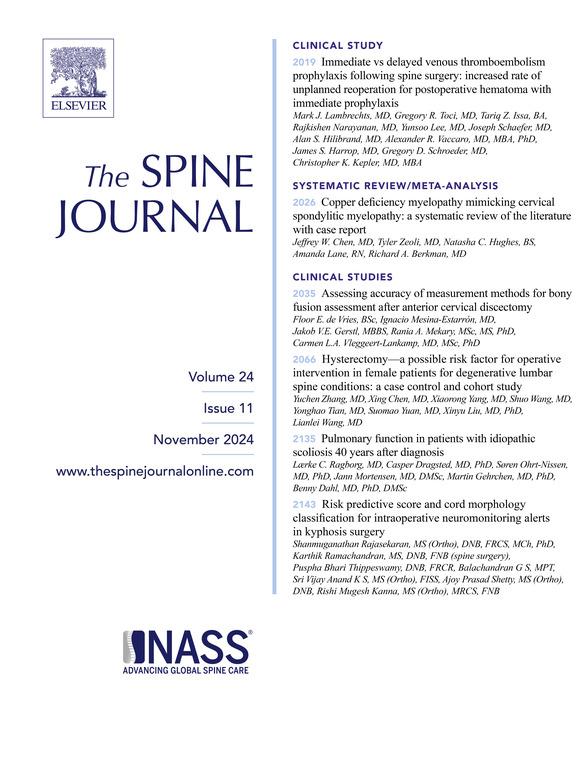28. 经腹平面阻滞对腰椎前路椎体间融合术住院时间和术后阿片类药物使用的影响
IF 4.7
1区 医学
Q1 CLINICAL NEUROLOGY
引用次数: 0
摘要
背景:腰椎椎体间融合术(ALIF)在美国是一种越来越常见的外科手术,用于治疗各种脊柱疾病。由于阿片类药物的使用和医疗费用仍然是主要的国家医疗危机,了解脊柱手术中有效的疼痛管理方法,包括区域麻醉,是至关重要的。腹横面阻滞(TAP)已成为腹部和腹膜后一般外科手术中最常用的截骨阻滞之一。越来越多的证据表明TAP阻滞可以减少麻醉剂的使用,减少住院时间,改善普外科的疼痛评分。虽然TAP阻滞也常用于脊柱前路手术,但评估ALIF患者TAP阻滞后疗效的文献很少。目的:本回顾性队列研究旨在确定TAP阻滞对围手术期阿片类药物使用和住院时间的影响。研究设计/设置:回顾性队列研究。患者样本:共有295名年龄在18岁或以上的患者在同一机构接受了1级或2级ALIF,伴有或不伴有后路经皮内固定融合术。其中,102例患者术前接受了TAP阻滞,193例患者未接受TAP阻滞。观察结果:住院时间和术后吗啡毫当量。方法:经IRB批准后,对18岁或以上接受1级或2级ALIF伴或不伴后路经皮内固定融合术的患者进行回顾性图表回顾。同时行侧体间融合术、开放性后路脊柱减压术、翻修手术或3节段以上手术的患者被排除在分析之外。收集基线人口统计、手术细节、住院时间(LOS)和住院阿片类药物使用数据(转换为吗啡毫当量,MME)。收集总MME和按术后天数(POD)分层的MME。统计分析包括描述性统计、t检验和卡方检验。采用双变量和多变量回归模型分析TAP阻滞与术后LOS和麻醉使用的关系。结果共纳入295例患者,其中102例(34.6%)接受TAP阻滞,193例(65.4%)未接受TAP阻滞。在基线患者特征、融合节段数量或合并后路内固定融合的发生率方面没有显著差异。使用TAP阻滞对LOS没有统计学上的显著影响,双变量分析显示,当按性别、年龄、BMI、术前阿片类药物使用或融合水平数量进行分组分析时,没有影响。与没有TAP阻断的患者相比,TAP阻断患者在POD 0和联合POD 1和2上接受了更多的MME。在有或没有TAP阻断的患者中,POD 1 MME无显著差异。双变量分析没有揭示任何从TAP块中受益的亚组,而是揭示了接受TAP块的特定人口统计数据比没有TAP块的人口统计数据获得更多的MME。接受TAP阻断的女性平均获得77.2 MME,而未接受TAP阻断的女性平均获得63.5 MME (p = 0.026)。接受TAP阻断的BMI正常患者平均MME为82,而未接受TAP阻断的患者平均MME为45.2 (p = 0.009)。结论:我们的数据表明TAP阻滞对术后LOS或阿片类药物用量没有统计学意义的改变。根据迄今为止报道的最大的患者队列,我们的研究结果表明,对于接受ALIF的患者,不应该常规地进行TAP阻滞。FDA器械/药物状态本摘要不讨论或包括任何适用的器械或药物。本文章由计算机程序翻译,如有差异,请以英文原文为准。
28. Impact of transversus abdominis plane block on length of stay and postoperative opioid use in anterior lumbar interbody fusion
BACKGROUND CONTEXT
Anterior lumbar interbody fusion (ALIF) is an increasingly common surgical procedure in the United States for a variety of spinal pathologies. As both opioid use and healthcare costs remain major national healthcare crises, it is crucial to understand methods of effective pain management in spine surgery, including regional anesthesia. Transversus abdominis plane (TAP) blocks have become one of the most commonly performed truncal blocks for general surgery procedures of the abdomen and retroperitoneum. There is growing evidence that TAP blocks may result in decreased narcotic use, decreased length of stay, and improved pain scores in the general surgery setting. While TAP blocks are also commonly performed for anterior spinal surgery, literature evaluating outcomes after TAP blocks for ALIF patients is sparse.
PURPOSE
This retrospective cohort study aims to determine the effect of TAP blocks on perioperative opioid use and hospital length of stay.
STUDY DESIGN/SETTING
Retrospective cohort study.
PATIENT SAMPLE
A total of 295 patients aged 18 years or older undergoing 1- or 2-level ALIF at a single institution with or without associated posterior percutaneous instrumented fusion. Of these, 102 patients received a preoperative TAP block, while 193 patients did not receive a TAP block.
OUTCOME MEASURES
Hospital length of stay and postoperative morphine milliequivalents.
METHODS
Following IRB approval, retrospective chart review was performed for patients 18 years or older undergoing 1- or 2-level ALIF with or without associated posterior percutaneous instrumented fusion. Patients undergoing concomitant lateral interbody fusions, open posterior spinal decompression, revision surgery, or 3 or more level surgery were excluded from analysis. Baseline demographics, surgical details, length of stay (LOS), and data on inpatient opioid use (converted to morphine milliequivalents, MME) were collected. Total MME and MME stratified by postoperative day (POD) was collected. Statistical analysis included descriptive statistics, t-tests, and chi-square tests where appropriate. Bivariate and multivariate regression models were used to analyze the relationship of TAP blocks with LOS and narcotic use postoperatively.
RESULTS
In total, 295 patients were included, with 102 (34.6%) undergoing TAP block and 193 (65.4%) patients without TAP block. There were no significant differences in baseline patient characteristics, number of levels fused, or prevalence of concomitant posterior instrumented fusion. Use of a TAP block had no statistically significant effect on LOS, and bivariate analysis revealed no effect when groups were analyzed by sex, age, BMI, preoperative opioid use, or number of levels fused. TAP block patients received significantly more MME on POD 0 and on combined POD 1 and 2 than those without a TAP block. There was no significant difference in POD 1 MME between patients with or without TAP block. Bivariate analysis did not reveal any subgroup who benefitted from a TAP block, but rather revealed that certain demographics who received a TAP block received more MME than those without a TAP block. Females who received a TAP block received a mean 77.2 MME, compared to 63.5 MME in those without a TAP block (p = 0.026). Patients with a normal BMI who received a TAP block received a mean 82 MME versus 45.2 MME in those without a TAP block (p = 0.009).
CONCLUSIONS
Our data would suggest that TAP blocks do not provide statistically significant changes in LOS or quantity of postoperative opioid medication consumed. With the largest patient cohort reported to date, our results suggest that TAP blocks should not be routinely performed for patients undergoing ALIF.
FDA Device/Drug Status
This abstract does not discuss or include any applicable devices or drugs.
求助全文
通过发布文献求助,成功后即可免费获取论文全文。
去求助
来源期刊

Spine Journal
医学-临床神经学
CiteScore
8.20
自引率
6.70%
发文量
680
审稿时长
13.1 weeks
期刊介绍:
The Spine Journal, the official journal of the North American Spine Society, is an international and multidisciplinary journal that publishes original, peer-reviewed articles on research and treatment related to the spine and spine care, including basic science and clinical investigations. It is a condition of publication that manuscripts submitted to The Spine Journal have not been published, and will not be simultaneously submitted or published elsewhere. The Spine Journal also publishes major reviews of specific topics by acknowledged authorities, technical notes, teaching editorials, and other special features, Letters to the Editor-in-Chief are encouraged.
 求助内容:
求助内容: 应助结果提醒方式:
应助结果提醒方式:


